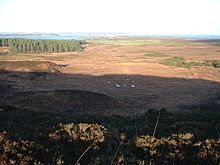Studland and Godlingston Heath National Nature Reserve facts for kids
| Site of Special Scientific Interest | |

View over Studland and Godlingston Heath
|
|
| Area of Search | Dorset |
|---|---|
| Grid reference | SZ030845 |
| Interest | biological, historical, ornithological |
| Area | 759 hectares (1,880 acres) |
| Notification | 1954 |
The Studland and Godlingston Heaths National Nature Reserve is a special place found on the Isle of Purbeck in Dorset, England. It's located right next to Studland Bay, between the towns of Swanage and Sandbanks. This large nature reserve covers about 631 hectares (that's like 1,560 acres!). The National Trust looks after this amazing area. It's one of England's "spotlight reserves" and is also known as a Site of Special Scientific Interest (SSSI) because of its unique nature.
Contents
Amazing Habitats and Wildlife
This reserve is super important because it has a lot of different natural areas. It's mostly made up of lowland heath, which is a rare type of open land with small shrubs. But it also has many other cool places like sand dunes, wet peat bogs, and forests with alder and willow trees. There are even freshwater lagoons, like a small lake called "Little Sea," and 5 kilometers (about 3 miles) of sandy beach.
Reptiles and Birds
All six types of native British reptiles live here! This includes the very rare and endangered sand lizard and the smooth snake. These animals need special habitats to survive.
The reserve is also a strong home for the rare Dartford warbler, a small bird. These birds managed to survive here even when very cold winters nearly wiped them out in other parts of southern England.
Ancient History and Mysterious Rocks
This nature reserve has many signs of people living here long, long ago, even before Roman times. You can see ancient burial mounds, called tumuli, marked on maps.
The reserve also holds a mysterious standing stone known as the Agglestone Rock. It's a huge sandstone rock that stands alone, looking like a giant mushroom.
Fire Risk and Past Uses
The reserve can easily catch fire during hot, dry summers. Large areas have burned in the past, but they always grow back.
This area was also used for training before D-Day during World War II. Soldiers practiced here, and the Royal Air Force used it for bombing and shooting practice.
Visiting Studland and Godlingston Heaths
The reserve is open to visitors all year round. You can get there by car using the Sandbanks Ferry from Poole or Bournemouth in the north. Or, you can drive from Wareham in the west using the A351 and B3351 roads.
Public Transport Options
If you prefer trains, there's a main train service by South Western Railway to Wareham station. In the summer, the Swanage Railway steam train runs from Wareham to Swanage, passing by Corfe Castle. Local buses also run between Wareham, Swanage, and South Haven Point. You can find places to stay and other visitor facilities in Studland village, which is right next to the reserve.
Other Nature Reserves Nearby
The Natural England organization has its local office near Wareham. From there, they also manage other nature reserves like Stoborough Heath NNR and Hartland Moor NNR.
The RSPB also has a large nature reserve at Arne. The Dorset Wildlife Trust manages two reserves at East Creech and the special Purbeck Marine Wildlife Reserve at Kimmeridge. The National Trust also owns and manages Ballard Down, a large chalk grassland ridge south of Studland, as a nature reserve.

